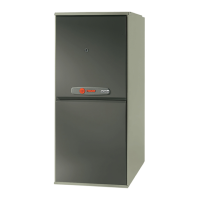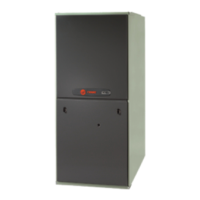18-CD26D1-10 17
Installer’s Guide
VENT FITTING MATERIAL – PLASTIC
Gas and liquid tight single wall vent fittings, designed for
resistance to corrosive flue condensate, MUST be used
throughout.
Listed in Table 9, page 18, are designations for different
types of 2" and 3" size pipe and fittings that meet these
requirements. The materials listed are various grades of
PVC, CPVC, and ABS plastic.
PIPE JOINTS: All joints must be fastened and sealed to
prevent escape of combustion products into the building.
NOTE: It is recommended that the first joints from the
Furnace be connected and sealed with high temperature
RTV. This will enable the pipes to be removed later without
cutting.
Be sure to properly support these joints.
BONDING OF PVC
Commercially available solvent cement for PVC must be
used to join PVC pipe fittings. Follow instructions on
container carefully.
Pipe and Fitting – ASTM D1785, D2466, D2661, & D2665
PVC Primer and Solvent Cement – ASTM D2564
Procedure for Cementing Joints – Ref ASTM D2855
1. Cut pipe square, remove ragged edges and burrs. Cham-
fer end of pipe, then clean fitting socket and pipe joint
area of all dirt, grease, moisture or chips.
2. After checking pipe and socket for proper fit, wipe socket
and pipe with cleaner-primer. Apply a liberal coat of
primer to inside surface of socket and outside of pipe.
DO NOT ALLOW PRIMER TO DRY BEFORE APPLY-
ING CEMENT.
3. Apply a thin coat of cement evenly in the socket. Quickly
apply a heavy coat of cement to the pipe end and insert
pipe into fitting with a slight twisting movement until it
bottoms out.
4. Hold the pipe in the fitting for 30 seconds to prevent
tapered socket from pushing the pipe out of the fitting.
5. Wipe all excess cement from the joint with a rag. Allow
15 minutes before handling. Cure time varies according
to fit, temperature and humidity.
Seal VENT PIP
with RTV seala
eal INLET AIR PIPE
with RTV sealant
Front of Furnace
VENT AND INLET AIR CONNECTIONS
Figure 26
NOTE: Follow venting instructions carefully when using PVC
cement.
IMPORTANT: All joints must be water tight. Flue condensate
is somewhat acidic, and leaks can cause equipment
damage.
Connection of the pipe and collar of the combustion air inlet
should just be a friction fit. It is recommended that the inlet
air joint be sealed with RTV type sealant to allow the joint to
be separated for possible future service. The inlet and vent
pipes must be properly supported throughout the entire
length. See Figure 26.
NOTE: Vent termination kit BAYAIR30AVENTA or
BAYVENT200B may be used in addition to the horizontal
and vertical termination options shown in the following
figures. For Canadian applications ONLY, IPEX 196006 may
be used for horizontal and vertical terminations. IPEX
081216, IPEX 081218, and IPEX 081219 may only be used
for horizontal vent terminations.
Important: Products installed in Canada must use vent
systems that are certified to the Standard for Type BH Gas
Venting Systems (ULC S636) for Class II-A venting sys-
tems (up to 65°C). Components of the vent system must
not be interchanged with other vent systems or unlisted
pipe or fittings. Plastic components, specified primers, and
glues must be from a single system manufacturer and not
intermixed with other system manufacturer's vent system
parts. In addition, the first three feet of the vent pipe must
be visible for inspection.

